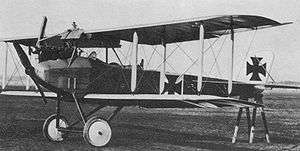Albatros C.I
| Albatros C.I | |
|---|---|
 | |
| Role | Reconnaissance aircraft |
| Manufacturer | Albatros Flugzeugwerke |
| Introduction | 1915 |
| Retired | 1917[1] |
| Primary users | Luftstreitkräfte Polish Air Force Lithuanian Air Force |
| Developed from | Albatros B.II |
| Variants | Albatros C.III |
The Albatros C.I was the first of the successful C-series of two-seat general-purpose biplanes built by Albatros Flugzeugwerke during World War I. Based on the unarmed Albatros B.II, the C.I reversed the pilot and observer seating so that the observer occupied the rear cockpit which was fitted with a ring-mounted 7.92 mm (0.312 in) Parabellum MG14 machine gun.
Design and development
When the C.I first appeared in early 1915, its good handling and powerful 110 kW (150 hp) Benz Bz.III engine gave it an edge over most Allied aircraft.[2] During development of the type, successively more powerful engines were fitted, culminating in the 130 kW (180 hp) Argus As III which allowed the final version of the C.Ia to achieve 140 km/h (87 mph) at sea level with an operational ceiling of 3,000 m (9,840 ft).[1] A dual-control variant, designated the C.Ib, was built as a trainer aircraft by Mercur Flugzeugbau. Improvements to the C.I resulted in the Albatros C.III which became the most prolific of the Albatros C-types.
Operational history
While the C.I was operated mainly in a reconnaissance and observation role, it also had some success as an early fighter aircraft - Oswald Boelcke claimed his first victory while flying a C.I with Lt. von Wühlisch as the gunner. Germany's most famous World War I aviator, Manfred von Richthofen, also began his career as an observer in the C.I on the Eastern Front.
Variants
- C.I
- Two-seat reconnaissance aircraft. First production version.
- C.Ia
- Improved version powered by more powerful Argus As III engine, built by BFW and by LFG
- C.Ib
- Dual-control training version built by Mercur Flugzeugbau.
- C.If
- C.Ifd
- C.I-V
- Experimental aircraft. One built.
Operators
- Lithuanian Air Force operated this type postwar.
- Polish Air Force operated 49 aircraft postwar.
- Swedish Air Force (Postwar)
Specifications (C.I)
Data from German aircraft of the First World War[3]
General characteristics
- Crew: 2
- Length: 7.85 m (25 ft 9 in)
- Wingspan: 12.9 m (42 ft 4 in)
- Height: 3.14 m (10 ft 3⅝ in)
- Wing area: 40.4 m2 (437 ft2)
- Empty weight: 875 kg (1,925 lb)
- Gross weight: 1,190 kg (2,618 lb)
- Powerplant: 1 × Mercedes D.III, 119 kW (160 hp)
Performance
- Maximum speed: 132 km/h (82.5 mph)
- Endurance: 2½ hours
- Service ceiling: 3,000 m (9,840 ft)
- Rate of climb: 1.7 m/s (336.5 ft/min)
Armament
- 1 × 7.92 mm (0.312 in) Parabellum MG14 machine gun in observer's cockpit
See also
- Related development
- Aircraft of comparable role, configuration and era
- Related lists
References
Notes
Bibliography
- Angelucci, Enzo. The Rand McNally Encyclopedia of Military Aircraft, 1914-1980. San Diego, California: The Military Press, 1983. ISBN 0-517-41021-4.
- Cowin, H.W. German and Austrian Aviation of World War I. Oxford, UK: Osprey Publishing Ltd, 2000. ISBN 1-84176-069-2.
- Gray, Peter and Owen Thetford. German aircraft of the First World War. London: Putnam, 1970, 2nd edition. ISBN 0-370-00103-6.
- van Wyngarden, G. Early German Aces of World War I. Oxford, UK: Osprey Publishing Ltd, 2006. ISBN 1-84176-997-5
External links
| Wikimedia Commons has media related to Albatros C.I. |
- Profile of the plane on page of the Polish Aviation Museum
- Air-to-air photo dated 1916 at Airliners.net